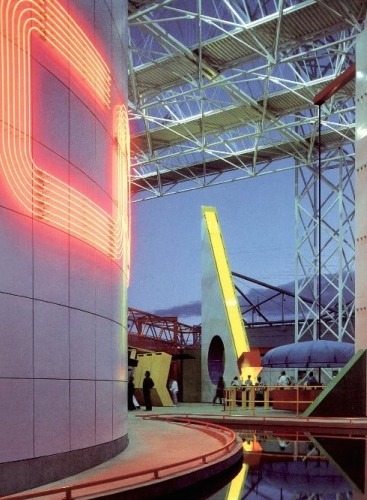Sunday, August 24, 1986.
THE ACTOR PLAYS 10 ROLES, demonstrating the versatility of the professional trouper.
The aircraft plays one role, an example of inspired type casting.
In the elaborate audio-visual shows being offered by Canada’s crown corporations, personality is everything. At both the Air Canada and Canadian National Pavilions, Expo visitors can enjoy the special thrill of seeing real talent on display.
The national airline built a 200-seat theatre and its 15-minute show, Kaleidoscope, around CF-TCC, a twin-engined Lockheed 10A, the first aircraft purchased by the newly-created Trans-Canada Air Lines. Visitors are seated in a balcony above the plane, and the 195-projector slide show begins when the 10A’s engines roar to life in a simulation of TCA’s first scheduled flight.
It began from the Sea Island Airport (now Vancouver International), and was flown by the TCC’s sister ship, CF-AYZ. The destination was Seattle and it occurred on September 1, 1937, with “ceiling and visibility unlimited.”
Directed by Paul Smith of Vancouver’s Creative House, Kaleidoscope has a terrific opening that is followed by some fascinating historic photos offering a nostalgic chronicle of the TCA story. Thereafter, it becomes less interesting, more a commercial-like catalogue of current destinations and departures.
LocoMotion, in the C.N. Pavilion’s 300-seat theatre, is built around the sturdy personality of Gordon Pinsent. Clad in a jogging suit, the Newfoundland-born actor appears life-size on a special screen that strolls with his image across the front of the auditorium beneath a wall-to-wall main screen.
The show, a whimsical history of the Canadian railroad, links 45 slide- and a pair of movie projectors. Pinsent appears on the main screen in a variety of roles, all of whom interact conversationally with jogger Pinsent.
As directed by Toronto’s John McGreevy, the program manages to be both irreverent and laced with regional humour. Although a laser-beam-smoke-pot ending assuring us of C.N.’s rosy future is less than convincing, LocoMotion manages to be fun for its full 15 minutes.
The above is a restored version of a Province review by Michael Walsh originally published in 1986. For additional information on this archived material, please visit my FAQ.
Afterword: I first heard about Crown corporations as an elementary school student in the 1950s. It was a time when people honestly believed that governments acted in the public interest and worked for the greater good. We learned that Ottawa and the 10 Canadian provinces had the power to create Crown corporations — business enterprises owned and operated by government — to provide necessary public services that were either too risky or too expensive for private entrepreneurs. We learned about the postal service, the first intercolonial railroads, the C.N.R., Ontario Hydro and Air Canada (founded in 1937 as Trans-Canada Air Lines). Generally operated at arm's length from the government, they reflected public policy in the best sense, and were thought of as good things.
When I encountered the Crown corporation pavilions at Expo 86, there were new ideas coming into prominence. International leaders such as Britain’s Prime Minister Margaret Thatcher and U.S. President Ronald Reagan were espousing an economic philosophy that demonized government. They promoted “free enterprise” and “free market values,” clever slogans that put a positive spin on policies that involved the wholesale transfer of public wealth into the hands of private business. Sadly, Canada was not immune to such dubious notions. The same month that Expo 86 opened in Vancouver, Canadian and U.S. negotiators had their first FTA meeting.
The document that they produced, the politically contentious Free Trade Agreement, was signed into law in January, 1988. Three months later, Prime Minister Brian Mulroney’s government announced its intention to privatize Air Canada that summer. Teleglobe, the Crown corporation that sponsored the Expo 86 film The Taming of the Demons, had already been sold off in early 1987. Canadian National was privatized in November, 1995. The world, as I’m sure we all agree, has been a better place ever since.
See also: The eight articles included in this, the fourth of four Expo 86 special reports, explore the pavilions of:
|
31: Expo 86 CP/GM (Bob Rogers) 32: Expo 86 Telecom Canada 33: Expo 86 Air Canada/CNR 34: Expo 86 Islam/Christianity |
